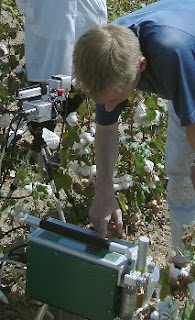Some
like it hot. Others not.
“It’s brutal,” field scout Carlos Silva says about
the scorching 100 degree-plus weather that enveloped the San Joaquin Valley
much of last week.Like many others who work outdoors, Carlos isn’t looking forward
to another scorcher this week.
On the flip side, some do like it hot. Take cotton
plants.
Cotton can thrive in really hot weather. You
might say it’s in the genes – cotton originated in hot, tropical climates and
can live in very high temperatures, especially irrigated cotton.
Here’s a little science: The optimum
air temperature range for cotton photosynthesis is 77 to 113 degrees.
Photosynthesis, in short, is the foundation of plant life in which the sun’s
rays are captured by the plant to create sugar necessary for growth.
The impact of high air temperatures on cotton really depends
on the plant tissue. Like humans, cotton plants let water evaporate from its
tissue – we call it sweat in humans – to stay cool. Well-water cotton plants
have been found to be 10 degrees cooler than the air temperature, according to
scientists. One study measured plant canopy temperature at 88 degrees on a
blistering 121-degree day in Arizona.
 Interestingly, the evaporative
cooling of cotton in July can provide the same cooling output as up to 100 average
home air conditioners, according to a July 1990 article by Kater Hake and Jeff Silvertooth
in a National Cotton Council publication, Physiology Today. (The title is “High Temperature Effects on Cotton.) The key, they note, is maintaining an ideal tissue
temperature range of 74 to 90 degrees. Another important factor is providing
adequate water for the plant to use to cool itself.
Interestingly, the evaporative
cooling of cotton in July can provide the same cooling output as up to 100 average
home air conditioners, according to a July 1990 article by Kater Hake and Jeff Silvertooth
in a National Cotton Council publication, Physiology Today. (The title is “High Temperature Effects on Cotton.) The key, they note, is maintaining an ideal tissue
temperature range of 74 to 90 degrees. Another important factor is providing
adequate water for the plant to use to cool itself.
The authors point out that yield and
quality are tied to temperatures. By understanding the effects of hot spells on
cotton, growers can make the timely adjustments on the production practices to
maintain yield and quality. Dry soil, high humidity, bright sunny days, plant
diseases and high night temperatures can play a role in tissue temperatures.
 |
| Checking moisture content in cotton. |
Without adequate moisture, the plant
can’t stay cool enough and that will impact yield. “Hot” cotton is not good.
Quality, though, is less susceptible
to hot temperatures, which often cuts short the boll setting process. That
means fewer, poor quality late-set bolls.
During high temperatures, growers should keep the moisture
high and surface soil moist. Too much water, though, will create waterlog
conditions and can cause cotton to wilt and die. Growers need to keep an eye on
fruit retention during hot weather, which will spur growth.
The bottom line advice: use frequent
light irrigations during hot, hot weather.
Meanwhile, in the fields and
orchards, Carlos and almond field scout Jenna Mayfield report relatively low
pest pressures. They had anticipated a surge because of the heat wave.
Jenna says many orchards are showing
signs of hull split. Carlos says the hot weather has spurred cotton and alfalfa
growth this past week. Look for growers to start cutting alfalfa within the
week.
In cotton, fruit retention remains
good. But lygus bugs are still showing up in some fields and fruit drop is
evident there. Growers will have to decide whether to treat, Carlos points out.
The exciting news is cotton plants
are at first bloom. Soon we’ll start seeing cotton fields
come alive with colorful flowers.









